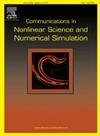二阶变时间步长,解耦,线性化和无条件稳定的Boussinesq方程数值格式
IF 3.8
2区 数学
Q1 MATHEMATICS, APPLIED
Communications in Nonlinear Science and Numerical Simulation
Pub Date : 2025-06-06
DOI:10.1016/j.cnsns.2025.108980
引用次数: 0
摘要
研究时变Boussinesq方程的二阶变时间步长DLN算法。所考虑的数值格式具有以下特点:二阶性、解耦性、线性化和无条件稳定性。为了达到上述优点,采用半隐式格式处理非线性项,给出了数值格式的稳定性结果,并得到了数值解的最优误差估计。在有限元法的框架下,设计了Boussinesq方程的全离散数值格式。给出了相应的稳定性和最优l2范数误差估计。最后,给出了一些数值结果来验证所建立的理论结果,并展示了所考虑的数值格式的性能。本文章由计算机程序翻译,如有差异,请以英文原文为准。
The second order variable time step, decoupled, linearized and unconditional stable numerical scheme for the Boussinesq equations
This paper considers the second order variable time-step DLN algorithm for the time-dependent Boussinesq equations. The considered numerical scheme maintains the following features: second order, decoupling, linearization and unconditional stability. In order to achieve the above mentioned merits, the semi-implicit scheme is adopted to treat the nonlinear terms, the stability results of numerical scheme are provided, and the optimal error estimates of numerical solutions are obtained. Furthermore, the fully discrete numerical scheme for the Boussinesq equations is designed in the framework of the finite element method. The corresponding stability and optimal -norm error estimates are also presented. Finally, some numerical results are given to verify the established theoretical findings and show the performances of the considered numerical scheme.
求助全文
通过发布文献求助,成功后即可免费获取论文全文。
去求助
来源期刊

Communications in Nonlinear Science and Numerical Simulation
MATHEMATICS, APPLIED-MATHEMATICS, INTERDISCIPLINARY APPLICATIONS
CiteScore
6.80
自引率
7.70%
发文量
378
审稿时长
78 days
期刊介绍:
The journal publishes original research findings on experimental observation, mathematical modeling, theoretical analysis and numerical simulation, for more accurate description, better prediction or novel application, of nonlinear phenomena in science and engineering. It offers a venue for researchers to make rapid exchange of ideas and techniques in nonlinear science and complexity.
The submission of manuscripts with cross-disciplinary approaches in nonlinear science and complexity is particularly encouraged.
Topics of interest:
Nonlinear differential or delay equations, Lie group analysis and asymptotic methods, Discontinuous systems, Fractals, Fractional calculus and dynamics, Nonlinear effects in quantum mechanics, Nonlinear stochastic processes, Experimental nonlinear science, Time-series and signal analysis, Computational methods and simulations in nonlinear science and engineering, Control of dynamical systems, Synchronization, Lyapunov analysis, High-dimensional chaos and turbulence, Chaos in Hamiltonian systems, Integrable systems and solitons, Collective behavior in many-body systems, Biological physics and networks, Nonlinear mechanical systems, Complex systems and complexity.
No length limitation for contributions is set, but only concisely written manuscripts are published. Brief papers are published on the basis of Rapid Communications. Discussions of previously published papers are welcome.
 求助内容:
求助内容: 应助结果提醒方式:
应助结果提醒方式:


